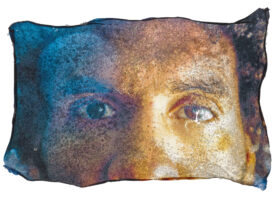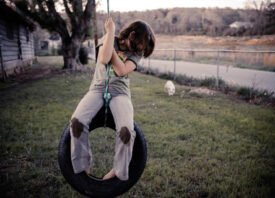Search this site
Fast Fashion’s Problem with Modern Slavery

Last year, a report from the international human rights group Walk Free revealed that one in 130 women and girls around the world are living in modern slavery. Modern slavery includes human trafficking, forced labor, slavery and slavery-like practices, debt bondage, forced marriage, and the worst forms of child labor; in 2018, Walk Free found that, after technology, the fashion industry was the second-largest sector to support modern slavery practices.
These are the numbers, but for the Minneapolis-based photographer and social justice advocate Marla Klein, they only tell part of the story. “When you throw statistics and numbers in peoples’ faces, it doesn’t always make a human connection,” she tells us. “But when you show artwork that gives a face to the movement, people pay attention.”
Her project How Many Hands is a testament to the estimated 40.3 million people trapped and exploited as part of modern slavery practices, many within the garment industry. “My friend and co-creative director of the shoot, Sica Dawn, and I had a prompt for a photo competition that asked for fashion photos that commented on a social cause,” she remembers.
“And we thought, ‘Why not comment on the fashion industry itself?’ So much of our clothing is made by the hands of enslaved people subjected to inhumane working conditions. No one talks about this. We could have a fashion shoot with no real clothing in it.” We asked Klein to tell us more about the series, a collaboration between herself, Dawn, and models Fernanda Almeida, Cianneh Browne, and Haim Park.

How has learning about the fashion industry’s problem with slavery influenced your own everyday choices?
“I’ve always been a thrifty person, but working on this project put fast fashion at the forefront of my mind. I now buy most of my clothing secondhand, both for myself and for a lot of my photo shoots. If I do buy new, I try to find clothing makers that create their pieces sustainably. This, of course, costs more for new clothing, but it also ensures I buy super versatile clothes I’ll wear many times over.”

How did you bring this idea to life?
“We shot everything in my studio in about four hours, including the hands. We purposely chose women of color to be the main models and had an all-female crew. Eighty percent of the estimated 40-60 million garment workers worldwide, according to the Clean Clothes Campaign, are female, and roughly 10% of commercial photographers/crew members are female. So having that representation was key for us.
“I shot each photo in layers of hands with my camera on a tripod. Hand models would stand behind the model, wrap their arms around her like actual clothing, and rearrange the hand position with each photo grouping to ensure a variety of positions I could choose later in post. The most challenging part was definitely the retouching. I did it all myself and cut out each hand by hand. Overall I’d guess it was about 20 to 30 hours of work in post-production.”

Why do you think so few people are talking about this problem, and what can we all do to get that conversation going?
“I’m definitely not an expert, but I would guess part of it is that so much ‘fast fashion’ clothing is made overseas, and we don’t see it openly in the US, even if we’re supporting it with our purchases. It’s difficult to personally meet someone who has been enslaved in these particular working conditions, although the US certainly faces its own minimum wage issues.
“I think the best way to spark conversation and raise awareness is through empathy and art. I love using my photographic voice and platform to uplift others. As photographers, we can do that by working with brands that align with our values, and we can also do it by documenting protests and rallies in order to get the word out. Humans are visual creatures, and we tend to care more about causes when we can see beautiful and impactful imagery.”

All images © Marla Klein


